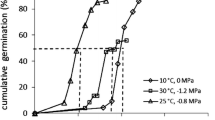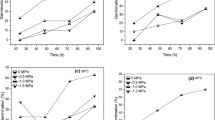Abstract
Understanding factors influencing the time of weed seedling establishment can contribute to developing predictive models for control measures at early growth stages. Non-linear regression models (Dent-like and Quadratic polynomial) and hydrothermal time models were considered for estimating cardinal temperature and predicting the emergence time of the Setaria species (S. viridis, S. verticillata, and S. glauca) at different constant temperatures and water potentials. Field experiments were also conducted, in which seeds of the species were sown and seedling emergence was recorded daily. The optimum temperature for germination was 27.7, 30.2, and 30.5 °C as estimated by a Dent-like model at 0 MPa water potential for S. glauca, S. viridis and S. verticillata, respectively. According to the hydrotime model, the minimum amount of base water potential (Ψb) was observed at the optimum temperatures, while it reached its highest value at temperatures exceeding the optimum. Overall, at sub-optimal temperatures, with the decrease in water potential, the thermal time (TT) constant increased linearly until − 0.6 MPa, but this trend was downward at supra-optimal temperatures. The hydrothermal time constant (θHT) was 213.5, 228.8, and 318.8 MPa °C h for S. viridis, S. verticillata, and S. glauca, respectively. Non-linear regression and hydrothermal models showed that S. glauca can emerge earlier than other species because of lower base temperature and a higher hydrothermal time constant. Setaria species did not show a significant difference in their tolerance to water stress by similar base water potential (Ψb(50) ~ − 0.5).







Similar content being viewed by others
References
Acharya BR, Roy Choudhury S, Estelle AB, Vijayakumar A, Zhu C, Hovis L, Pandey S (2017) Optimization of phenotyping assays for the model monocot Setaria viridis. Front Plant Sci 8:2172–2173
Al-Ahmadi JM, Kafi M (2007) Cardinal temperatures for germination of Kochia scoparia (L.). J Arid Environ 68(2):308–314
Alvarado V, Bradford KJ (2002) A hydrothermal time model explains the cardinal temperatures for seed germination. Plant Cell Environ 25(8):1061–1069
Amini V, Zaefarian F, Rezvani M (2015) Effect of pre-chilling and environmental factors on breaking seed dormancy and germination of three foxtail species. Acta Agric Slov 105(2):269–278
Baskin CC, Baskin JM (2001) Seeds, ecology, biogeography and evolution of dormancy, and germination. Plant Ecol 152(2):204–205
Baskin JM, Baskin CC (1988) Role of temperature in regulating the timing of germination in Portulaca oleracea. Can J Bot 66(3):563–567
Batlla D, Benech-Arnold RL (2007) Predicting changes in dormancy level in weed seed soil banks: implications for weed management. Crop Prot 26(3):189–197
Blackshaw RE, Stobbe EH, Shaykewich CF, Woodbury W (1981a) Influence of soil temperature and soil moisture on green foxtail (Setaria viridis) establishment in wheat (Triticum aestivum). Weed Sci 29(2):179–184
Blackshaw RE, Stobbe EH, Sturko ARW (1981b) Effect of seeding dates and densities of green foxtail (Setaria viridis) on the growth and productivity of spring wheat (Triticum aestivum). Weed Sci 29(2):212–217
Born WV (1971) Green foxtail: seed dormancy, germination and growth. Can J Plant Sci 51(1):53–59
Bradford KJ (1990) A water relations analysis of seed germination rates. Plant Physiol 94(2):840–849
Bradford KJ (1995) Water relations in seed germination. In: Kigel J, Galili G (eds) Seed development and germination. Marcel Dekker, Inc., New York, pp 351–396
Bradford KJ (2002) Applications of hydrothermal time to quantifying and modeling seed germination and dormancy. Weed Sci 50(2):248–260
Bradford KJ, Somasco OA (1994) Water relations of lettuce seed thermoinhibition. I. Priming and endosperm effects on base water potential. Seed Sci Res 4(1):1–10
Bradford KJ, Still DW (2004) Applications of hydrotime analysis in seed testing. Seed Technol 26:75–85
Chauhan BS, Johnson DE (2008) Influence of environmental factors on seed germination and seedling emergence of eclipta (Eclipta prostrata) in a tropical environment. Weed Sci 56(3):383–388
Chauhan BS, Johnson DE (2009) Influence of tillage systems on weed seedling emergence pattern in rainfed rice. Soil Till Res 106(1):15–21
Colbach N, Dürr C, Roger-Estrade J, Chauvel B, Caneill J (2006) AlomySys: Modelling black-grass (Alopecurus myosuroides Huds.) germination and emergence, in interaction with seed characteristics, tillage and soil climate: I. Construction. Eur J Agron 24(2):95–112
Dahal P, Bradford KJ (1994) Hydrothermal time analysis of tomato seed germination at suboptimal temperature and reduced water potential. Seed Sci Res 4(2):71–80
Dekker J (2003) The foxtail (Setaria) species-group. Weed Sci 51(5):641–656
Dekker J, Dekker B, Hilhorst H, Karssen C (1996) Weedy adaptation in Setaria spp. IV. Changes in the germinative capacity of S. faberii (Poaceae) embryos with development from anthesis to after abscission. Am J Bot 83(8):979–991
Del Monte JP, Dorado J (2011) Effects of light conditions and after-ripening time on seed dormancy loss of Bromus diandrus Roth. Weed Res 51(6):581–590
Forcella F, Arnold RLB, Sanchez R, Ghersa CM (2000) Modeling seedling emergence. Field Crops Res 67(2):123–139
Forcella F, Peterson DH, Barbour JC (1996) Timing and measurement of weed seed shed in corn (Zea mays). Weed Technol 10(3):535–543
Grundy AC, Phelps K, Reader RJ, Burston S (2000) Modelling the germination of Stellaria media using the concept of hydrothermal time. New Phytol 148(3):433–444
Guillemin JP, Gardarin A, Granger S, Reibel C, Munier-Jolain N, Colbach N (2013) Assessing potential germination period of weeds with base temperatures and base water potentials. Weed Res 53(1):76–87
Gulden RH, Thomas AG, Shirtliffe SJ (2004) Secondary dormancy, temperature, and burial depth regulate seedbank dynamics in canola. Weed Sci 52(3):382–388
Gummerson RJ (1986) The effect of constant temperatures and osmotic potentials on the germination of sugar beet. J Exp Bot 37(6):729–741
Hegarty TW (1978) The physiology of seed hydration and dehydration, and the relation between water stress and the control of germination: a review. Plant Cell Environ 1(2):101–119
Holm LG, Holm L, Holm E, Pancho JV, Herberger JP (1997) World weeds: natural histories and distribution. Wiley, New York, pp 756–768
Holm LG, Plucknett DL, Pancho JV, Herberger JP (1991) The world's worst weeds. Distribution and biology. University Press of Hawaii, Hawaii
Kebreab E, Murdoch AJ (1999) Modelling the effects of water stress and temperature on germination rate of Orobanche aegyptiaca seeds. J Exp Bot 50(334):655–664
Lemieux C, Vallee L, Vanasse A (2003) Predicting yield loss in maize fields and developing decision support for post-emergence herbicide applications. Weed Res 43(5):323–332
Lindquist JL, Mortensen DA, Clay SA, Schmenk R, Kells JJ, Howatt K, Westra P (1996) Stability of corn (Zea mays)-velvetleaf (Abutilon theophrasti) interference relationships. Weed Sci 44(2):309–313
Maguire JD (1962) Speed of germination—aid in selection and evaluation for seedling emergence and vigor 1. Crop Sci 2(2):176–177
Michel BE, Radcliffe D (1995) A computer program relating solute potential to solution composition for five solutes. Agron J 87(1):126–130
Moradi R, Koocheki A, Mahallati MN, Mansoori H (2013) Adaptation strategies for maize cultivation under climate change in Iran: irrigation and planting date management. Mitig Adapt Strateg Glob Chang 18(2):265–284
Mundree SG, Baker B, Mowla S, Peters S, Marais S, Vander Willigen C, Thomson JA (2002) Physiological and molecular insights into drought tolerance. Afr J Biotechnol 1(2):28–38
Nadeau LB, Morrison IN (1986) Influence of soil moisture on shoot and root growth of green and yellow foxtail (Setaria viridis and S. lutescens). Weed Sci 34(2):225–232
Nieto H, Staniforth DW (1961) Corn-foxtail competition under various production conditions 1. Agron J 53(1):1–5
Ogg AG, Dawson JH (1984) Time of emergence of eight weed species. Weed Sci 32(3):327–335
Radosevish S, Holt J, Ghersa C (1997) Weed ecology, 2nd edn. Wiley, New York
Rahman A, Ashford R (1972) Control of green foxtail in wheat with trifluralin. Weed Sci 20(1):23–27
Roman ES, Thomas AG, Murphy SD, Swanton CJ (1999) Modeling germination and seedling elongation of common lambsquarters (Chenopodium album). Weed Sci 47(2):149–155
Sabila MH, Grey TL, Webster TM, Vencill WK, Shilling DG (2012) Evaluation of factors that influence Benghal dayflower (Commelina benghalensis) seed germination and emergence. Weed Sci 60(1):75–80
Sebastian J, Wong MK, Tang E, Dinneny JR (2014) Methods to promote germination of dormant Setaria viridis seeds. PLoS ONE 9(4):e95109
Shurtleff JL, Coble HD (1985) The interaction of soybean (Glycine max) and five weed species in the greenhouse. Weed Sci 33(5):669–672
Soltani A, Hammer GL, Torabi B, Robertson MJ, Zeinali E (2006) Modeling chickpea growth and development: phenological development. Field Crops Res 99(1):1–13
Soltani E, Adeli R, Akbari GA, Ramshini H (2017) Application of hydrotime model to predict early vigour of rapeseed (Brassica napus L.) under abiotic stresses. Acta Physiol Plant 39(11):252–263
Steinmaus SJ, Prather TS, Holt JS (2000) Estimation of base temperatures for nine weed species. J Exp Bot 51(343):275–286
Taylorson RB (1986) Water stress-induced germination of giant foxtail (Setaria faberi) seeds. Weed Sci 34(6):871–875
Taylorson RB, Brown MM (1977) Accelerated after-ripening for overcoming seed dormancy in grass weeds. Weed Sci 25(6):473–476
Tribouillois H, Dürr C, Demilly D, Wagner MH, Justes E (2016) Determination of germination response to temperature and water potential for a wide range of cover crop species and related functional groups. PLoS ONE 11(8):1–16
Trudgill DL, Perry JN (1994) Thermal time and ecological strategies—a unifying hypothesis. Ann Appl Biol 125(3):521–532
Trudgill DL, Honek A, Li D, Van Straalen NM (2005) Thermal time—concepts and utility. Ann Appl Biol 146(1):1–14
Acknowledgements
The authors wish to acknowledge the support provided to this work by the Ferdowsi Universityof Mashhad, Iran through the research program (Project No. 3/40529).
Author information
Authors and Affiliations
Corresponding author
Ethics declarations
Conflicts of interest
No conflicts of interest have been declared.
Additional information
Communicated by F. Araniti.
Publisher's Note
Springer Nature remains neutral with regard to jurisdictional claims in published maps and institutional affiliations.
Rights and permissions
About this article
Cite this article
Mollaee, M., Darbandi, E.I., Aval, M.B. et al. Germination response of three Setaria species (S. viridis, S. verticillata, and S. glauca) to water potential and temperature using non-linear regression and hydrothermal time models. Acta Physiol Plant 42, 149 (2020). https://doi.org/10.1007/s11738-020-03133-w
Received:
Revised:
Accepted:
Published:
DOI: https://doi.org/10.1007/s11738-020-03133-w




